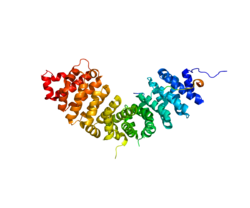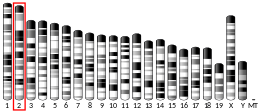P120 catenin
| CTNND1 | |||||||||||||||||||||||||||||||||||||||||||||||||||
|---|---|---|---|---|---|---|---|---|---|---|---|---|---|---|---|---|---|---|---|---|---|---|---|---|---|---|---|---|---|---|---|---|---|---|---|---|---|---|---|---|---|---|---|---|---|---|---|---|---|---|---|
 | |||||||||||||||||||||||||||||||||||||||||||||||||||
| |||||||||||||||||||||||||||||||||||||||||||||||||||
| Identifiers | |||||||||||||||||||||||||||||||||||||||||||||||||||
| Aliases | CTNND1, CAS, CTNND, P120CAS, P120CTN, p120, p120(CAS), p120(CTN), catenin delta 1, BCDS2 | ||||||||||||||||||||||||||||||||||||||||||||||||||
| External IDs | OMIM: 601045; MGI: 105100; HomoloGene: 1017; GeneCards: CTNND1; OMA:CTNND1 - orthologs | ||||||||||||||||||||||||||||||||||||||||||||||||||
| |||||||||||||||||||||||||||||||||||||||||||||||||||
| |||||||||||||||||||||||||||||||||||||||||||||||||||
| |||||||||||||||||||||||||||||||||||||||||||||||||||
| |||||||||||||||||||||||||||||||||||||||||||||||||||
| |||||||||||||||||||||||||||||||||||||||||||||||||||
| Wikidata | |||||||||||||||||||||||||||||||||||||||||||||||||||
| |||||||||||||||||||||||||||||||||||||||||||||||||||
p120 catenin, or simply p120, also called catenin delta-1, is a protein that in humans is encoded by the CTNND1 gene.[5]
Function
This gene encodes a member of the Armadillo protein family, which function in adhesion between cells and signal transduction. Multiple translation initiation codons and alternative splicing result in many different isoforms being translated. Not all of the full-length natures of the described transcript variants have been determined.[6]
Clinical significance

Either loss or cytoplasmic localization of p120 is a common feature in the progression of several types of carcinoma.[7]
Interactions
CTNND1 has been shown to interact with:
See also
References
- ^ a b c GRCh38: Ensembl release 89: ENSG00000198561 – Ensembl, May 2017
- ^ a b c GRCm38: Ensembl release 89: ENSMUSG00000034101 – Ensembl, May 2017
- ^ "Human PubMed Reference:". National Center for Biotechnology Information, U.S. National Library of Medicine.
- ^ "Mouse PubMed Reference:". National Center for Biotechnology Information, U.S. National Library of Medicine.
- ^ Reynolds AB, Jenkins NA, Gilbert DJ, Copeland NG, Shapiro DN, Wu J, Daniel JM (October 1996). "The gene encoding p120cas, a novel catenin, localizes on human chromosome 11q11 (CTNND) and mouse chromosome 2 (Catns)". Genomics. 31 (1): 127–9. doi:10.1006/geno.1996.0020. PMID 8808291.
- ^ "Entrez Gene: CTNND1 catenin (cadherin-associated protein), delta 1".
- ^ Schackmann, R. C. J.; Tenhagen, M.; van de Ven, R. A. H.; Derksen, P. W. B. (2013). "p120-catenin in cancer - mechanisms, models and opportunities for intervention". Journal of Cell Science. 126 (16): 3515–3525. doi:10.1242/jcs.134411. ISSN 0021-9533. PMID 23950111.
- ^ a b Hazan RB, Norton L (April 1998). "The epidermal growth factor receptor modulates the interaction of E-cadherin with the actin cytoskeleton". J. Biol. Chem. 273 (15): 9078–84. doi:10.1074/jbc.273.15.9078. PMID 9535896.
- ^ Kucerová D, Sloncová E, Tuhácková Z, Vojtechová M, Sovová V (December 2001). "Expression and interaction of different catenins in colorectal carcinoma cells". Int. J. Mol. Med. 8 (6): 695–8. doi:10.3892/ijmm.8.6.695. PMID 11712088.
- ^ a b c Piedra J, Miravet S, Castaño J, Pálmer HG, Heisterkamp N, García de Herreros A, Duñach M (2003). "p120 Catenin-associated Fer and Fyn tyrosine kinases regulate beta-catenin Tyr-142 phosphorylation and beta-catenin-alpha-catenin Interaction". Mol. Cell. Biol. 23 (7): 2287–97. doi:10.1128/MCB.23.7.2287-2297.2003. PMC 150740. PMID 12640114.
- ^ Daniel JM, Reynolds AB (September 1995). "The tyrosine kinase substrate p120cas binds directly to E-cadherin but not to the adenomatous polyposis coli protein or alpha-catenin". Mol. Cell. Biol. 15 (9): 4819–24. doi:10.1128/mcb.15.9.4819. PMC 230726. PMID 7651399.
- ^ Ireton RC, Davis MA, van Hengel J, Mariner DJ, Barnes K, Thoreson MA, Anastasiadis PZ, Matrisian L, Bundy LM, Sealy L, Gilbert B, van Roy F, Reynolds AB (2002). "A novel role for p120 catenin in E-cadherin function". J. Cell Biol. 159 (3): 465–76. doi:10.1083/jcb.200205115. PMC 2173073. PMID 12427869.
- ^ Kinch MS, Clark GJ, Der CJ, Burridge K (1995). "Tyrosine phosphorylation regulates the adhesions of ras-transformed breast epithelia". J. Cell Biol. 130 (2): 461–71. doi:10.1083/jcb.130.2.461. PMC 2199929. PMID 7542250.
- ^ Bonné S, Gilbert B, Hatzfeld M, Chen X, Green KJ, van Roy F (2003). "Defining desmosomal plakophilin-3 interactions". J. Cell Biol. 161 (2): 403–16. doi:10.1083/jcb.200303036. PMC 2172904. PMID 12707304.
- ^ Shibamoto S, Hayakawa M, Takeuchi K, Hori T, Miyazawa K, Kitamura N, Johnson KR, Wheelock MJ, Matsuyoshi N, Takeichi M (1995). "Association of p120, a tyrosine kinase substrate, with E-cadherin/catenin complexes". J. Cell Biol. 128 (5): 949–57. doi:10.1083/jcb.128.5.949. PMC 2120395. PMID 7876318.
- ^ Ohkubo T, Ozawa M (July 1999). "p120(ctn) binds to the membrane-proximal region of the E-cadherin cytoplasmic domain and is involved in modulation of adhesion activity". J. Biol. Chem. 274 (30): 21409–15. doi:10.1074/jbc.274.30.21409. PMID 10409703.
- ^ Straub BK, Boda J, Kuhn C, Schnoelzer M, Korf U, Kempf T, Spring H, Hatzfeld M, Franke WW (December 2003). "A novel cell-cell junction system: the cortex adhaerens mosaic of lens fiber cells". J. Cell Sci. 116 (Pt 24): 4985–95. doi:10.1242/jcs.00815. PMID 14625392.
- ^ Wahl JK, Kim YJ, Cullen JM, Johnson KR, Wheelock MJ (May 2003). "N-cadherin-catenin complexes form prior to cleavage of the proregion and transport to the plasma membrane". J. Biol. Chem. 278 (19): 17269–76. doi:10.1074/jbc.M211452200. PMID 12604612.
- ^ Aho S, Rothenberger K, Uitto J (1999). "Human p120ctn catenin: tissue-specific expression of isoforms and molecular interactions with BP180/type XVII collagen". J. Cell. Biochem. 73 (3): 390–9. doi:10.1002/(SICI)1097-4644(19990601)73:3<390::AID-JCB10>3.0.CO;2-1. PMID 10321838. S2CID 43899550.
- ^ a b Martinez MC, Ochiishi T, Majewski M, Kosik KS (2003). "Dual regulation of neuronal morphogenesis by a delta-catenin-cortactin complex and Rho". J. Cell Biol. 162 (1): 99–111. doi:10.1083/jcb.200211025. PMC 2172717. PMID 12835311.
- ^ Li Y, Kufe D (February 2001). "The Human DF3/MUC1 carcinoma-associated antigen signals nuclear localization of the catenin p120(ctn)". Biochem. Biophys. Res. Commun. 281 (2): 440–3. doi:10.1006/bbrc.2001.4383. PMID 11181067.
- ^ Lehtonen S, Lehtonen E, Kudlicka K, Holthöfer H, Farquhar MG (2004). "Nephrin forms a complex with adherens junction proteins and CASK in podocytes and in Madin-Darby canine kidney cells expressing nephrin". Am. J. Pathol. 165 (3): 923–36. doi:10.1016/S0002-9440(10)63354-8. PMC 1618613. PMID 15331416.
- ^ Tanahashi H, Tabira T (February 1999). "Isolation of human delta-catenin and its binding specificity with presenilin 1". NeuroReport. 10 (3): 563–8. doi:10.1097/00001756-199902250-00022. PMID 10208590.
- ^ Keilhack H, Hellman U, van Hengel J, van Roy F, Godovac-Zimmermann J, Böhmer FD (August 2000). "The protein-tyrosine phosphatase SHP-1 binds to and dephosphorylates p120 catenin". J. Biol. Chem. 275 (34): 26376–84. doi:10.1074/jbc.M001315200. PMID 10835420.
- ^ Holsinger LJ, Ward K, Duffield B, Zachwieja J, Jallal B (October 2002). "The transmembrane receptor protein tyrosine phosphatase DEP1 interacts with p120(ctn)". Oncogene. 21 (46): 7067–76. doi:10.1038/sj.onc.1205858. PMID 12370829.
- ^ Zondag GC, Reynolds AB, Moolenaar WH (April 2000). "Receptor protein-tyrosine phosphatase RPTPmu binds to and dephosphorylates the catenin p120(ctn)". J. Biol. Chem. 275 (15): 11264–9. doi:10.1074/jbc.275.15.11264. PMID 10753936.
- ^ Ferber A, Yaen C, Sarmiento E, Martinez J (March 2002). "An octapeptide in the juxtamembrane domain of VE-cadherin is important for p120ctn binding and cell proliferation". Exp. Cell Res. 274 (1): 35–44. doi:10.1006/excr.2001.5436. PMID 11855855.
- ^ Lampugnani MG, Corada M, Andriopoulou P, Esser S, Risau W, Dejana E (September 1997). "Cell confluence regulates tyrosine phosphorylation of adherens junction components in endothelial cells". J. Cell Sci. 110 (17): 2065–77. doi:10.1242/jcs.110.17.2065. PMID 9378757.
- ^ Daniel JM, Reynolds AB (May 1999). "The catenin p120(ctn) interacts with Kaiso, a novel BTB/POZ domain zinc finger transcription factor". Mol. Cell. Biol. 19 (5): 3614–23. doi:10.1128/mcb.19.5.3614. PMC 84161. PMID 10207085.
Further reading
- Wijnhoven BP, Dinjens WN, Pignatelli M (2000). "E-cadherin-catenin cell-cell adhesion complex and human cancer". The British Journal of Surgery. 87 (8): 992–1005. doi:10.1046/j.1365-2168.2000.01513.x. hdl:1765/56571. PMID 10931041. S2CID 3083613.
- Thoreson MA, Reynolds AB (2003). "Altered expression of the catenin p120 in human cancer: implications for tumor progression". Differentiation. 70 (9–10): 583–9. doi:10.1046/j.1432-0436.2002.700911.x. PMID 12492499.
- Reynolds AB, Carnahan RH (2005). "Regulation of cadherin stability and turnover by p120ctn: implications in disease and cancer". Semin. Cell Dev. Biol. 15 (6): 657–63. doi:10.1016/j.semcdb.2004.09.003. PMID 15561585.
- Keil R, Wolf A, Hüttelmaier S, Hatzfeld M (2007). "Beyond regulation of cell adhesion: local control of RhoA at the cleavage furrow by the p0071 catenin". Cell Cycle. 6 (2): 122–7. doi:10.4161/cc.6.2.3741. PMID 17264675.
- Kinch MS, Clark GJ, Der CJ, Burridge K (1995). "Tyrosine phosphorylation regulates the adhesions of ras-transformed breast epithelia". J. Cell Biol. 130 (2): 461–71. doi:10.1083/jcb.130.2.461. PMC 2199929. PMID 7542250.
- Daniel JM, Reynolds AB (1995). "The tyrosine kinase substrate p120cas binds directly to E-cadherin but not to the adenomatous polyposis coli protein or alpha-catenin". Mol. Cell. Biol. 15 (9): 4819–24. doi:10.1128/mcb.15.9.4819. PMC 230726. PMID 7651399.
- Shibamoto S, Hayakawa M, Takeuchi K, Hori T, Miyazawa K, Kitamura N, Johnson KR, Wheelock MJ, Matsuyoshi N, Takeichi M (1995). "Association of p120, a tyrosine kinase substrate, with E- cadherin/catenin complexes". J. Cell Biol. 128 (5): 949–57. doi:10.1083/jcb.128.5.949. PMC 2120395. PMID 7876318.
- Reynolds AB, Daniel JM, Mo YY, Wu J, Zhang Z (1996). "The novel catenin p120cas binds classical cadherins and induces an unusual morphological phenotype in NIH3T3 fibroblasts". Exp. Cell Res. 225 (2): 328–37. doi:10.1006/excr.1996.0183. PMID 8660921.
- Nagase T, Ishikawa K, Nakajima D, Ohira M, Seki N, Miyajima N, Tanaka A, Kotani H, Nomura N, Ohara O (1997). "Prediction of the coding sequences of unidentified human genes. VII. The complete sequences of 100 new cDNA clones from brain which can code for large proteins in vitro". DNA Res. 4 (2): 141–50. doi:10.1093/dnares/4.2.141. PMID 9205841.
- Lampugnani MG, Corada M, Andriopoulou P, Esser S, Risau W, Dejana E (1997). "Cell confluence regulates tyrosine phosphorylation of adherens junction components in endothelial cells". J. Cell Sci. 110 (17): 2065–77. doi:10.1242/jcs.110.17.2065. PMID 9378757.
- Hazan RB, Norton L (1998). "The epidermal growth factor receptor modulates the interaction of E-cadherin with the actin cytoskeleton". J. Biol. Chem. 273 (15): 9078–84. doi:10.1074/jbc.273.15.9078. PMID 9535896.
- Keirsebilck A, Bonné S, Staes K, van Hengel J, Nollet F, Reynolds A, van Roy F (1998). "Molecular cloning of the human p120ctn catenin gene (CTNND1): expression of multiple alternatively spliced isoforms". Genomics. 50 (2): 129–46. doi:10.1006/geno.1998.5325. PMID 9653641.
- Bauer A, Lickert H, Kemler R, Stappert J (1998). "Modification of the E-cadherin-catenin complex in mitotic Madin-Darby canine kidney epithelial cells". J. Biol. Chem. 273 (43): 28314–21. doi:10.1074/jbc.273.43.28314. PMID 9774455.
- Daniel JM, Reynolds AB (1999). "The Catenin p120ctn Interacts with Kaiso, a Novel BTB/POZ Domain Zinc Finger Transcription Factor". Mol. Cell. Biol. 19 (5): 3614–23. doi:10.1128/mcb.19.5.3614. PMC 84161. PMID 10207085.
- Aono S, Nakagawa S, Reynolds AB, Takeichi M (1999). "p120ctn Acts as an Inhibitory Regulator of Cadherin Function in Colon Carcinoma Cells". J. Cell Biol. 145 (3): 551–62. doi:10.1083/jcb.145.3.551. PMC 2185070. PMID 10225956.
- Aho S, Rothenberger K, Uitto J (1999). "Human p120ctn catenin: tissue-specific expression of isoforms and molecular interactions with BP180/type XVII collagen". J. Cell. Biochem. 73 (3): 390–9. doi:10.1002/(SICI)1097-4644(19990601)73:3<390::AID-JCB10>3.0.CO;2-1. PMID 10321838. S2CID 43899550.
- van Hengel J, Vanhoenacker P, Staes K, van Roy F (1999). "Nuclear localization of the p120ctn Armadillo-like catenin is counteracted by a nuclear export signal and by E-cadherin expression". Proc. Natl. Acad. Sci. U.S.A. 96 (14): 7980–5. doi:10.1073/pnas.96.14.7980. PMC 22173. PMID 10393933.
- Ohkubo T, Ozawa M (1999). "p120(ctn) binds to the membrane-proximal region of the E-cadherin cytoplasmic domain and is involved in modulation of adhesion activity". J. Biol. Chem. 274 (30): 21409–15. doi:10.1074/jbc.274.30.21409. PMID 10409703.
- Thoreson MA, Anastasiadis PZ, Daniel JM, Ireton RC, Wheelock MJ, Johnson KR, Hummingbird DK, Reynolds AB (2000). "Selective Uncoupling of P120ctn from E-Cadherin Disrupts Strong Adhesion". J. Cell Biol. 148 (1): 189–202. doi:10.1083/jcb.148.1.189. PMC 2156209. PMID 10629228.
External links
- Human CTNND1 genome location and CTNND1 gene details page in the UCSC Genome Browser.

















